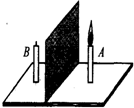问题
问答题
小刚在探究平面镜成像的实验时,用两段等长的蜡烛、一块玻璃板、刻度尺等器材做实验,如图所示.
(1)刻度尺是用来研究______的关系;
(2)用两段等长的蜡烛是为了比较物与像的______关系;
(3)移去蜡烛B,并在B的位置上放一光屏,则光屏______(填“能”或“不能”)接受到蜡烛A的像,这说明平面镜成的像是______像.
(4)小刚在实验中取得如下的数据:
| 蜡烛到平面镜的距离 | 蜡烛的像到平面镜的距离 |
| 15cm | 15cm |
| 20cm | 20cm |
| 30cm | 30cm |

答案
(1)在实验中用到刻度尺,但直尺并不是测量像、物的大小用的,而是测像到镜的距离、物到镜的距离,然后比较二者关系.
(2)两只蜡烛大小相同,后面的蜡烛又和前面蜡烛的像完全重合,这样就证明了像与物大小相同,所以两只蜡烛等长是为了比较像与物大小关系.
(3)由于虚像不能成在光屏上,所以移去第二根蜡烛,则它的位置放上一光屏,则在光屏上不能接受到蜡烛的像;
(4)实验中测了三组像到镜的距离和物到镜的距离,符合多次测量使结论更具普遍性的原则,发现每次数据都是相等的.
故答案为:(1)物体到平面镜的距离;(2)大小;(3)不能;虚;(4)物像到平面镜的距离相等.
